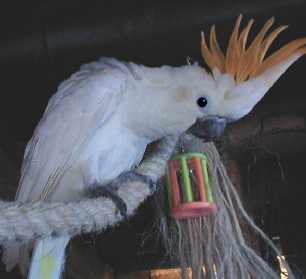Cockatoo - Citron
Sumba, Citron-Crested Cockatoo Scientific Name: Cacatua sulphurea citrinocristata
Thu, 3rd July, 2025 - 10:37 am GMT
Sponsor Ads:

Alternative Name
Sumba, Citron-Crested Cockatoo Scientific Name: Cacatua sulphurea citrinocristataBasic Info
At maturity, the Citron Crested Cockatoo is about 13 inches long. They have pristinely white plumage save over their heads and on the pale golden- washed undersides of their flight and tail feathers. Their crests are the defining feature of the Citron Crested Cockatoo, and are as lovely as they sound in the bird's name. A bright splash of citrus-like orange-yellow adorns the crest and is complimented by the paler yellow ear coverts. Citron Crested Cockatoos have gray legs and black bills, and they also have black eyes when they are babies. As they mature, the female's eyes will take on a reddish tinge while the male's will reman black. Usually, the crest of males may be a bit more impressive than that of a female, and his bill is also usually a bit bigger.
Health
Citron Crested Cockatoos may be a bit prone to chewing, so be sure they have plenty of items that they are allowed to destroy lest they turn in boredom to their cages or your furniture. When bored, these Cockatoos show a tendency to pluck out their own feathers. Breeding When breeding Citron Crested Cockatoos, it is of extreme importance that the breeding area includes hiding places where the female can escape should the male become overly aggressive. During breeding season, male Citrons have been known to kill females. Generally, Citron Crested Cockatoos becomes sexually mature between two and four years of age, and should be placed together with a nesting box in a large aviary for breeding. In the wild, mating occurs between September and October. Usually, a T shaped nesting box will be a good choice for the Citron Crested Cockatoo. Although Citron Crested Cockatoos usually lay two eggs, three is fairly common and up to five is not unknown! These birds usually incubate the eggs for about three and a half to four weeks, and the fledgling period lasts between eight and ten weeks. It may be best to remove the young and hand raise them, as parental aggression is not unknown. Citron Crested Cockatoos can breed twice in one year.Habitat
N/ABehavior
Although they are rarer in aviculture than their close relative the Sulphur Crested Cockatoo, Citron Crested Cockatoos are highly valued by enthusiasts. Citron Crested Cockatoos are social birds, living in pairs or small groups in the wild. An extremely intelligent bird, the Citron Crested Cockatoo can be taught a variety of amusing tricks and will even perform its own original antics to catch your attention! These birds, although they may not be a good choice as a child's pet, have fairly gentle natures and quickly form loving bonds with their owners. They adore playtime and attention, although they may not be a good apartment bird since they can occasionally be a bit loud. Citron Crested Cockatoos love to chew, and so should be provided with a variety of chew items. They can be kept in aviaries of 15 by six by six feet. When kept in small enclosures, Citron Crested Cockatoos should be allowed plenty of time for exercise. The enclosure will need to be of metal, as these birds can chew right through wire mesh. Generally, Citron Crested Cockatoos may be fed a good seed mix or pellet diet supplemented with plenty of fruits, vegetables and greenfood. Especially nutritious favorites are peas and apples. Of course, they will also need fresh water available at all times. When your Citron Crested Cockatoo is annoyed, it will indicate this to you by raising and lowering its crest, and if it is extremely alarmed it may hiss. Once acclimatized and familiar with you, Citron Crested Cockatoos tend to make hardy and sweetly affectionate pets.Origin
IndonesiaHistory
Citron Crested Cockatoos are native to the Sumba Islands located off the coast of mainland Indonesia. Sadly, in the wild these birds are very much endangered. They have tendencies to raid agricultural areas from time to time in search of food, which does not aid in their popularity. As pets, they tend to be a bit more even-tempered than the Sulphur Crested Cockatoo, and their great beauty makes them a favorite of many people.Common Foods
They eat fruits, berries, flowers, nuts and seeds in the wild and will associate with Eclectus Parrots or other birds from time to time.Sponsor Ads:
It is better to be envied than to be consoled. -- Unknown
Cockatoo - Citron
Coded by: BGID® | ALL RIGHTS RESERVED Copyright © 2000-2025
Disclaimer | Privacy | Report Errors / Contact | Credits








 President of the United States of America - Real Estate mogul, Pageant owner and now one of the most controversial men in political history.
President of the United States of America - Real Estate mogul, Pageant owner and now one of the most controversial men in political history.  Global warming has been in and out as the "latest" hot topic for many years. It is, according to modern scientists, the result of man-made industrial pollutants, clearing forested areas, agriculture, etc. But now they are thinking it started way before the Industrial Revolution...
Global warming has been in and out as the "latest" hot topic for many years. It is, according to modern scientists, the result of man-made industrial pollutants, clearing forested areas, agriculture, etc. But now they are thinking it started way before the Industrial Revolution...  Politician, US Vice President and President of the USA - Joseph Robinette Biden Jr.
Politician, US Vice President and President of the USA - Joseph Robinette Biden Jr.  versus
versus  Russia: 'The Evil Empire'? Are they all that bad or is it just the USA trying to portray Russia as bad because they are a world power with land bigger and a society very different from the USA ideal?
Russia: 'The Evil Empire'? Are they all that bad or is it just the USA trying to portray Russia as bad because they are a world power with land bigger and a society very different from the USA ideal? 
 Corona virus
Corona virus 
 Users with wide screen monitors can benefit from more content on every page.
Users with wide screen monitors can benefit from more content on every page.